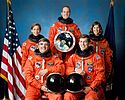STS-32
| STS-32 | |||||
 | |||||
| Uppdrag | 33 | ||||
|---|---|---|---|---|---|
| Rymdfärja | Columbia (9)[1] | ||||
| NSSDC-ID | 1990-002A[2] | ||||
| Färdens tid | 10 dagar, 21 timmar, 0 minuter, 36 sekunder | ||||
| Uppskjutning | |||||
| Startplats | Startplatta 39A vid Kennedy Space Center i Florida | ||||
| Start | 07:35 (EST) 9 januari 1990 | ||||
| Landning | |||||
| Landningsplats | Edwards Air Force Base i Kalifornien | ||||
| Landning | 01:35 (PST) 20 januari 1990 | ||||
| Omloppsbana | |||||
| Varv | 172 st[3] | ||||
| Apogeum | 361 km | ||||
| Perigeum | 296 km | ||||
| Banlutning | 28,5° | ||||
| Sträcka | 7,258 miljoner km | ||||
| Besättning | |||||
| Befälhavare | Daniel C. Brandenstein (3) | ||||
| Pilot | James D. Wetherbee (1) | ||||
| Uppdragsspecialister | Bonnie J. Dunbar (2) G. David Low (1) Marsha S. Ivins (1) | ||||
 | |||||
| Kronologi Rymdfärjeprogrammet | |||||
| |||||
STS-32 var den trettiotredje flygningen i det amerikanska rymdfärjeprogrammet och nionde i ordningen för rymdfärjan Columbia. Den sköts upp från Pad 39A vid Kennedy Space Center i Florida den 9 januari 1990. Efter nästan elva dagar i omloppsbana runt jorden återinträdde rymdfärjan i jordens atmosfär och landade vid Edwards Air Force Base i Kalifornien.
Uppdragets mål
Huvuduppgifterna för detta uppdrag var att placera ännu en av amerikanska försvarets leasade kommunikationssatelliter, SYNCOM IV-F5 (LEASAT 5), i omloppsbana samt att fånga in LDEF (Long Duration Exposure Facility) och ta med den tillbaka till jorden.
Noterbart
När LDEF fångades in var det 4,5 år efter det planerade infångandet. Uppdraget för att frakta LDEF till jorden fördröjdes efter olyckan med rymdfärjan Challenger under uppdragen STS-51-L. Det befarades att om infångandet senarelades ytterligare skulle förhöjd solaktivitet (med högre partikeltäthet i omloppsbanan som följd) orsaka inbromsning och höjdförlust, vilket i sin tur skulle leda till att LDEF skulle brinna upp i atmosfären.
Väckningar
Under Geminiprogrammet började NASA spela musik för besättningar och sedan Apollo 15 har man varje "morgon" väckt besättningen med ett musikstycke, särskilt utvalt antingen för en enskild astronaut eller för de förhållanden som råder.
| Dag | Låt | Artist/Kompositör |
|---|---|---|
| 2 | "What’s More American?" | Bing Crosby |
| 3 | "The Banana Boat Song" parodi | |
| 4 | "Let It Snow" parodi | |
| 5 | "Hello Dolly" parodi | |
| 6 | "Attack of the Killer Tomatoes" | |
| 7 | "Notre Dame Victory March" | |
| 8 | "Bow Down to Washington" | University of Washington |
| 9 | "Glory, Glory, Colorado" | University of Colorado |
| 10 | "Danny Boy" | Larry Bird |
| 11 | "Washington and Lee" | Washington and Lee University |
| 12 | "Born to Be Wild" | Steppenwolf |
| 13 | "Anchors Aweigh" | Charles A. Zimmerman |
Se även
Referenser
- ^ NASA Space Shuttle Launch Archive Arkiverad 7 december 2008 hämtat från the Wayback Machine., läst 28 juli 2016.
- ^ ”NASA Space Science Data Coordinated Archive” (på engelska). NASA. https://nssdc.gsfc.nasa.gov/nmc/spacecraft/display.action?id=1990-002A. Läst 18 mars 2020.
- ^ Manned Astronautics - Figures & Facts Arkiverad 4 mars 2016 hämtat från the Wayback Machine., läst 28 juli 2016.
Externa länkar
 Wikimedia Commons har media som rör STS-32.
Wikimedia Commons har media som rör STS-32.
| ||||||||
| ||||||||||||||||||||||||||||||||
Media som används på denna webbplats
Författare/Upphovsman: Pascal (Flickr user: pasukaru76), Licens: CC0
Vostok spacecraft replica at the Technik Museum Speyer, Germany.
STS-33 Mission Insignia
STS-32 Mission Insignia
- The STS-32 patch, designed by the five crewmembers for the January, 1990 space mission, depicts the Space Shuttle orbiter rendezvousing with the Long Duration Exposure Facility (LDEF) satellite from above and the Syncom satellite successfully deployed and on its way to geosynchronous orbit. Five stars represent the mission number with three on one side of the orbiter and two on the other. The seven major rays of the sun are in remembrance of the crewmembers for STS 51-L. In preparation for the first Extended Duration Orbiter (EDO) missions, STS-32 conducted a number of medical and middeck scientific experiments. The caduceus on the left represents the medical experiments, and the crystalline structure on the right represents the materials science. The crew is comprised of Astronauts Daniel C. Brandenstein, James D. Wetherbee, Bonnie Dunbar, Marsha S. Ivins, and G. David Low.
STS-36 Mission Insignia
Five astronauts launched aboard the Space Shuttle Columbia on January 9, 1990 at 7:35:00am (EST) for the STS-32 mission. Pictured in their crew portrait, front left to right, are Daniel C. Brandenstein, commander; and James D. Weatherbee, pilot. Pictured rear left to right are mission specialists Marsha S. Ivins, G. David Low, and Bonnie J. Dunbar. Primary objectives of the mission were the deployment of the SYNCOM IV-F5 defense communications satellite and the retrieval of NASA's Long Duration Exposure Facility (LDEF).







